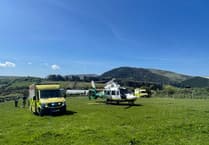No hearts were left untouched and no eyes were left dry during the public screening of Starfish - a film released in 2016 depicting how Nic and Tom’s relationship was utterly tested to its limits due to sepsis.
The Broadway Cinema was crammed with residents, along with MHKs Alex Allinson and Clare Bettison, and supporters and members of Manx charity Mannin Sepsis which had invited film director Bill Clark, producer Pippa Cross, Nic and Tom who would later answer the public’s questions about the life-threatening infection and more.
The crowd watched the Rays’ story unfold, beginning with their ’happy’ period as young parents.
Tom, played by Da Vinci’s Demons actor Tom Riley, was an at-home dad for their two-year-old daughter Grace who he would often take for trips out to a lake opposite their house in Rutland, England.
Nic, played by ITV Liar actress Joanne Froggatt, was expecting their second child Freddie when her husband’s health suddenly deteriorated in December 1999.
The Rays believe Tom contracted sepsis after a dental visit where the dentist had pricked his gum combined with a flu that he’d been recovering from.
Nic said: ’It was nothing more sinister than that... nothing really obvious, just an incidental thing. It was just this perfect storm of your immunity being low because you’ve had flu and this trip to the dentist was all it took.’
The film unashamedly does not shy away from the realities of the illness and its impact on the couple.
’We made a decision that wherever possible Tom would figure in the making of this film,’ Bill said.
As an audience we see what symptoms had a drastic affect on Tom, such as being violently sick, feeling cold and being in immense pain before going deathly white.
Tom tells me that sepsis makes ’you feel like you might die’.
He advised: ’If those symptoms come on, just say out loud to a medical professional "could this be sepsis?".
’The medical profession will probably consider about 100 different explanations for the sickness before they think about sepsis.
’If you don’t treat the sepsis quickly, it’ll kill you.’
In other scenes we see the heart-wrenching reaction Tom had after examining his body following surgery to remove his arms, legs and parts of his face that had become septic.
Bill said: ’[In the film] it’s a brilliant prosthetics moment... but then we shot real Tom examining the arms and the legs.
’We discussed this a lot, but if we were making a film about disability we had to be brave enough to face the disability ourselves.
’When Tom came in I said "I would really like to shoot your body in this section" it was like being at church. It really was a spiritual moment for everybody involved in the process.
’It was an incredible, moving process to be involved in this film.’
Pippa added: ’It was, I have to say, one of the more extraordinary sets I’ve ever been on. Tom and Nic were with us a lot and that can be quite a challenge for the actors... but actually it was such a supportive, extraordinary atmosphere.’
Joanne’s portrayal of Nic included the moment when Freddie arrived into the world while Tom was recovering in the intensive care unit.
Looking back on her experience, Nic said: ’It was just the worst thing and the best thing simultaneously and I can’t put it any better than that.’
Once Tom left the hospital in August 2000 Nic took on the role as his full-time carer, having to push and pull him up and down the stairs without the aid of prosthetic limbs and taking care of his personal hygiene - all while caring for their two little ones.
With both parents being out of work, the family struggled financially.
Nic successfully appealed to organisations and charitable members of the public to help them afford suitable prosthetic limbs to replace the hooks Tom had been given by the NHS for his hands.
Sadly, they ended up selling their patch of paradise by the lake and moved in with Nic’s mother to help them get by.
Despite gradual terseness towards one another - due to each other’s frustration, dismay, a slight lack of understanding and fatigue - their love and loyalty got them through and it’s very clear that it continues to this day.
Tom added: ’Starfish has its roots in sepsis... but it also stands for people who are trying to recover from any kind of setback - debt, divorce, separation, loss of all kinds and illness of other kinds.
’I work in a call centre now on minimum wage and I really struggle in lots of ways and have problems with my mental health... but I’ve got this amazing, fantastic relationship with the one person I always ever wanted to be with in my whole life and I’m still able to be with her.
’I have two wonderful children now growing up who I see every day and we get along and how incredible is that? How much is that worth?
’There are still fantastic things that remain about being alive and that’s one of the messages that Starfish gives out. It does that in its beautiful cinematography, fantastic direction, production and beautiful music.’
Both Tom and Nic have been giving public awareness talks about twice a week across the UK for the past four or five years. This is along with raising Freddie, now 18, and Grace, 21, who is studying at university in Manchester, and carrying out full-time jobs.
’When we talk about 45,000 people who die every year in the UK from this and then you think about their friends, their families, their loved ones there are hundreds of thousands of people who are affected by this,’ Tom continued.
’It’s really important that we do something about this problem and reduce the mortality and increase the awareness so people don’t have such bad outcomes as we did.
’If we can just make a small dent in that then any kind of embarrassment or inconvenience or nervousness that we have about our personal story is not really significant.’
They are thinking of having a break from the awareness events to spend more time with their kids.
In the Isle of Man, John Struthers from Mannin Sepsis says that based on the UK figures roughly 300 people will get sepsis every year. ’And we reckon about 60 people will die from sepsis,’ he said.
The charity has raised £12,000 so far towards purchashing a back-up blood analyser for the pathology laboratory at Noble’s Hospital.
’We’re hoping to get to £27,000 by December 7 to get the machine in time for the flu season and winter months,’ he said.

.jpeg?width=209&height=140&crop=209:145,smart&quality=75)
.png?width=209&height=140&crop=209:145,smart&quality=75)

